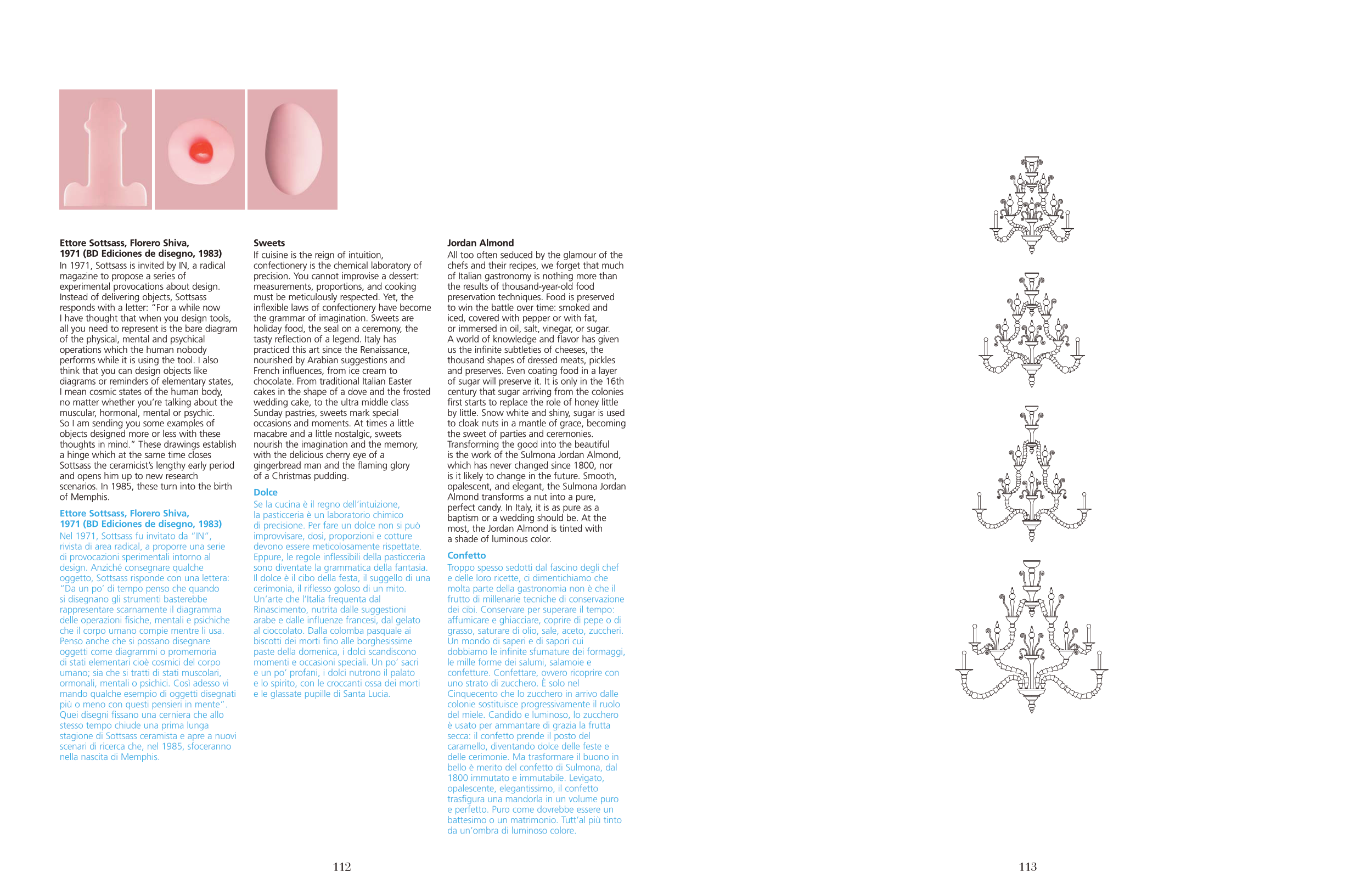113
112
Ettore Sottsass, Florero Shiva,
1971 (BD Ediciones de disegno, 1983)
In 1971, Sottsass is invited by IN, a radical
magazine to propose a series of
experimental provocations about design.
Instead of delivering objects, Sottsass
responds with a letter: “For a while now
I have thought that when you design tools,
all you need to represent is the bare diagram
of the physical, mental and psychical
operations which the human nobody
performs while it is using the tool. I also
think that you can design objects like
diagrams or reminders of elementary states,
I mean cosmic states of the human body,
no matter whether you’re talking about the
muscular, hormonal, mental or psychic.
So I am sending you some examples of
objects designed more or less with these
thoughts in mind.” These drawings establish
a hinge which at the same time closes
Sottsass the ceramicist’s lengthy early period
and opens him up to new research
scenarios. In 1985, these turn into the birth
of Memphis.
Ettore Sottsass, Florero Shiva,
1971 (BD Ediciones de disegno, 1983)
Nel 1971, Sottsass fu invitato da “IN”,
rivista di area radical, a proporre una serie
di provocazioni sperimentali intorno al
design. Anziché consegnare qualche
oggetto, Sottsass risponde con una lettera:
“Da un po’ di tempo penso che quando
si disegnano gli strumenti basterebbe
rappresentare scarnamente il diagramma
delle operazioni fisiche, mentali e psichiche
che il corpo umano compie mentre li usa.
Penso anche che si possano disegnare
oggetti come diagrammi o promemoria
di stati elementari cioè cosmici del corpo
umano; sia che si tratti di stati muscolari,
ormonali, mentali o psichici. Così adesso vi
mando qualche esempio di oggetti disegnati
più o meno con questi pensieri in mente”.
Quei disegni fissano una cerniera che allo
stesso tempo chiude una prima lunga
stagione di Sottsass ceramista e apre a nuovi
scenari di ricerca che, nel 1985, sfoceranno
nella nascita di Memphis.
Sweets
If cuisine is the reign of intuition,
confectionery is the chemical laboratory of
precision. You cannot improvise a dessert:
measurements, proportions, and cooking
must be meticulously respected. Yet, the
inflexible laws of confectionery have become
the grammar of imagination. Sweets are
holiday food, the seal on a ceremony, the
tasty reflection of a legend. Italy has
practiced this art since the Renaissance,
nourished by Arabian suggestions and
French influences, from ice cream to
chocolate. From traditional Italian Easter
cakes in the shape of a dove and the frosted
wedding cake, to the ultra middle class
Sunday pastries, sweets mark special
occasions and moments. At times a little
macabre and a little nostalgic, sweets
nourish the imagination and the memory,
with the delicious cherry eye of a
gingerbread man and the flaming glory
of a Christmas pudding.
Dolce
Se la cucina è il regno dell’intuizione,
la pasticceria è un laboratorio chimico
di precisione. Per fare un dolce non si può
improvvisare, dosi, proporzioni e cotture
devono essere meticolosamente rispettate.
Eppure, le regole inflessibili della pasticceria
sono diventate la grammatica della fantasia.
Il dolce è il cibo della festa, il suggello di una
cerimonia, il riflesso goloso di un mito.
Un’arte che l’Italia frequenta dal
Rinascimento, nutrita dalle suggestioni
arabe e dalle influenze francesi, dal gelato
al cioccolato. Dalla colomba pasquale ai
biscotti dei morti fino alle borghesissime
paste della domenica, i dolci scandiscono
momenti e occasioni speciali. Un po’ sacri
e un po’ profani, i dolci nutrono il palato
e lo spirito, con le croccanti ossa dei morti
e le glassate pupille di Santa Lucia.
Jordan Almond
All too often seduced by the glamour of the
chefs and their recipes, we forget that much
of Italian gastronomy is nothing more than
the results of thousand-year-old food
preservation techniques. Food is preserved
to win the battle over time: smoked and
iced, covered with pepper or with fat,
or immersed in oil, salt, vinegar, or sugar.
A world of knowledge and flavor has given
us the infinite subtleties of cheeses, the
thousand shapes of dressed meats, pickles
and preserves. Even coating food in a layer
of sugar will preserve it. It is only in the 16th
century that sugar arriving from the colonies
first starts to replace the role of honey little
by little. Snow white and shiny, sugar is used
to cloak nuts in a mantle of grace, becoming
the sweet of parties and ceremonies.
Transforming the good into the beautiful
is the work of the Sulmona Jordan Almond,
which has never changed since 1800, nor
is it likely to change in the future. Smooth,
opalescent, and elegant, the Sulmona Jordan
Almond transforms a nut into a pure,
perfect candy. In Italy, it is as pure as a
baptism or a wedding should be. At the
most, the Jordan Almond is tinted with
a shade of luminous color.
Confetto
Troppo spesso sedotti dal fascino degli chef
e delle loro ricette, ci dimentichiamo che
molta parte della gastronomia non è che il
frutto di millenarie tecniche di conservazione
dei cibi. Conservare per superare il tempo:
affumicare e ghiacciare, coprire di pepe o di
grasso, saturare di olio, sale, aceto, zuccheri.
Un mondo di saperi e di sapori cui
dobbiamo le infinite sfumature dei formaggi,
le mille forme dei salumi, salamoie e
confetture. Confettare, ovvero ricoprire con
uno strato di zucchero. È solo nel
Cinquecento che lo zucchero in arrivo dalle
colonie sostituisce progressivamente il ruolo
del miele. Candido e luminoso, lo zucchero
è usato per ammantare di grazia la frutta
secca: il confetto prende il posto del
caramello, diventando dolce delle feste e
delle cerimonie. Ma trasformare il buono in
bello è merito del confetto di Sulmona, dal
1800 immutato e immutabile. Levigato,
opalescente, elegantissimo, il confetto
trasfigura una mandorla in un volume puro
e perfetto. Puro come dovrebbe essere un
battesimo o un matrimonio. Tutt’al più tinto
da un’ombra di luminoso colore.


